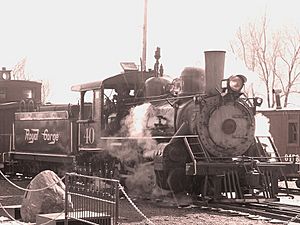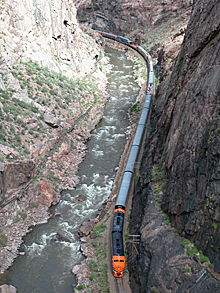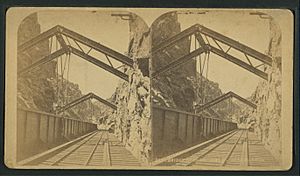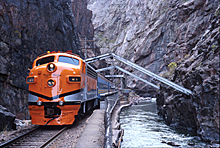Royal Gorge Route Railroad facts for kids
The Royal Gorge Route Railroad is a special train ride in Cañon City, Colorado. It's a "heritage railroad," meaning it uses old tracks and trains to show off history. This train takes you on a two-hour trip through the amazing Royal Gorge. This part of the track used to belong to the famous Denver and Rio Grande Western Railroad. The train, which looks like it's from the 1950s, leaves from the old Santa Fe train station in Cañon City every day.
Contents
A Race for the Tracks
In the late 1870s, many miners came to Colorado. They were looking for valuable metals like lead and silver. This mining boom happened near a town called Leadville. Two big railroad companies, the Rio Grande and the Santa Fe, wanted to build tracks to Leadville. They both wanted to carry the valuable metals and supplies.
The Santa Fe already had tracks in Pueblo. The Rio Grande had tracks closer, near Cañon City, Colorado. Leadville was about 100 miles (160 km) away. The best way to get there was through a long mountain valley. This valley included the Royal Gorge.
The Royal Gorge is a very deep and narrow canyon. It's about 6 miles (10 km) long. In some spots, the rock walls drop straight down into the river. This made it very hard to build a railroad. There was only enough space for one set of tracks.
On April 19, 1878, the Santa Fe railroad started building tracks. They began just west of Cañon City. The Rio Grande railroad also rushed its workers to the same spot. But the Santa Fe workers were already there. The Rio Grande was blocked. This was the start of a two-year fight. It became known as the Royal Gorge War. Both companies went to court. They each said they had the right to build there first.
The Royal Gorge War Begins
On August 23, 1878, a court decided in favor of the Santa Fe. It said Santa Fe could build tracks through the first 20 miles (32 km) of the canyon. This part included the Royal Gorge. The Rio Grande could build tracks too, but only if they didn't get in Santa Fe's way. If the canyon was too narrow, Rio Grande could use Santa Fe's tracks.
The Rio Grande didn't give up. They appealed the decision to the Supreme Court of the United States. While waiting, they started building tracks in the upper part of the canyon. The Santa Fe tried to stop them. Santa Fe also threatened to build tracks right next to all of Rio Grande's existing lines. This worried the Rio Grande's investors. They pressured the Rio Grande to let Santa Fe use their railroad.
So, the two companies made a deal. Santa Fe would lease all of Rio Grande's tracks, trains, and workers for 30 years. This deal started on December 13, 1878. Santa Fe could now reach Denver. But Santa Fe soon raised prices for shipping goods. This made it harder for Denver businesses. By March 1879, the Rio Grande tried to end the lease. They said Santa Fe was breaking the rules of the agreement.
Fighting for the Gorge
While the lawyers argued, both sides continued building. Workers were harassed. Rocks were rolled down on them. Tools were thrown into the river. Both companies hired armed groups of men. They wanted to control important spots in the gorge. Rio Grande workers even built 17 stone "forts" to block Santa Fe.
The Rio Grande's earnings were shrinking. So, they went to court to break the lease. While the case was in court, armed men hired by Santa Fe took over Rio Grande train stations. This group was led by Bat Masterson, a sheriff from Kansas. He brought other famous gunfighters with him.
On April 21, 1879, the Supreme Court made a big decision. It said the Rio Grande had the first right to build through the gorge. This was because of an earlier law from 1872. Masterson's group went back to Kansas. But the lease agreement was still a problem.
In June 1879, it looked like the Rio Grande would win. Masterson quickly returned with 60 men. They took over a strong position at the Santa Fe roundhouse in Pueblo. A court order on June 10, 1879, stopped Santa Fe from using Rio Grande tracks. The next day, Rio Grande workers took back their railroad.
Rio Grande leaders brought 100 men to Pueblo. They worked with the local sheriff and marshal. They wanted to get Masterson's men out of the roundhouse. Masterson had even taken a cannon from the state armory. He aimed it at the street. Rio Grande men gathered and got rifles. They marched to the train platform. They broke into the telegraph office. Masterson's men ran away through the back windows. They couldn't talk to their bosses anymore. When faced with a re-borrowed cannon, Masterson's men gave up the roundhouse.
Even though some stories say people died, there is no clear proof. The courts made the Rio Grande return property it had taken. But in late 1879, a rich railroad owner named Jay Gould helped the Rio Grande. He loaned them money and bought part of the company. He announced plans to build a new line to compete with Santa Fe.
After the Royal Gorge War
In the end, the two companies settled their fight outside of court. On March 27, 1880, they signed a deal called the "Treaty of Boston." This ended all their legal battles. The Rio Grande got its railroad back. The Rio Grande paid Santa Fe $1.8 million for the tracks Santa Fe had built in the gorge.
The Rio Grande started building again. Their tracks reached Leadville on July 20, 1880. Passenger trains ran through the gorge from 1880 until 1967. The Rio Grande also carried freight through the gorge until 1989. Then, the company joined with the Southern Pacific Railroad. The Southern Pacific took over the gorge line. In 1996, the Southern Pacific joined with the Union Pacific Railroad. A year later, Union Pacific closed the line through the gorge.
In 1997, Union Pacific agreed to sell the 12 miles (19 km) of track through the Royal Gorge. This was done to save this beautiful route. Two new companies bought the line. They started the new Royal Gorge Route Railroad. Passenger service began in May 1999.
The Hanging Bridge
A very cool part of the gorge route is the Hanging Bridge. It was built in 1879. It's located where the gorge gets very narrow, only 30 feet (9 meters) wide. The rock walls drop straight into the river here.
An engineer named C. Shallor Smith designed the bridge. It cost $11,759 to build. The bridge is 175 feet (53 meters) long. It hangs on one side from strong A-frame structures. These structures span the river and are anchored to the rock walls. The bridge has been made stronger over the years. It is still used by trains today.
The Royal Gorge Route Today
The Royal Gorge Route Railroad runs trains all year. They travel through the Royal Gorge from Cañon City, Colorado to Parkdale, Colorado. The train is a popular attraction. It carries passengers right under the famous Royal Gorge suspension bridge.
Images for kids















